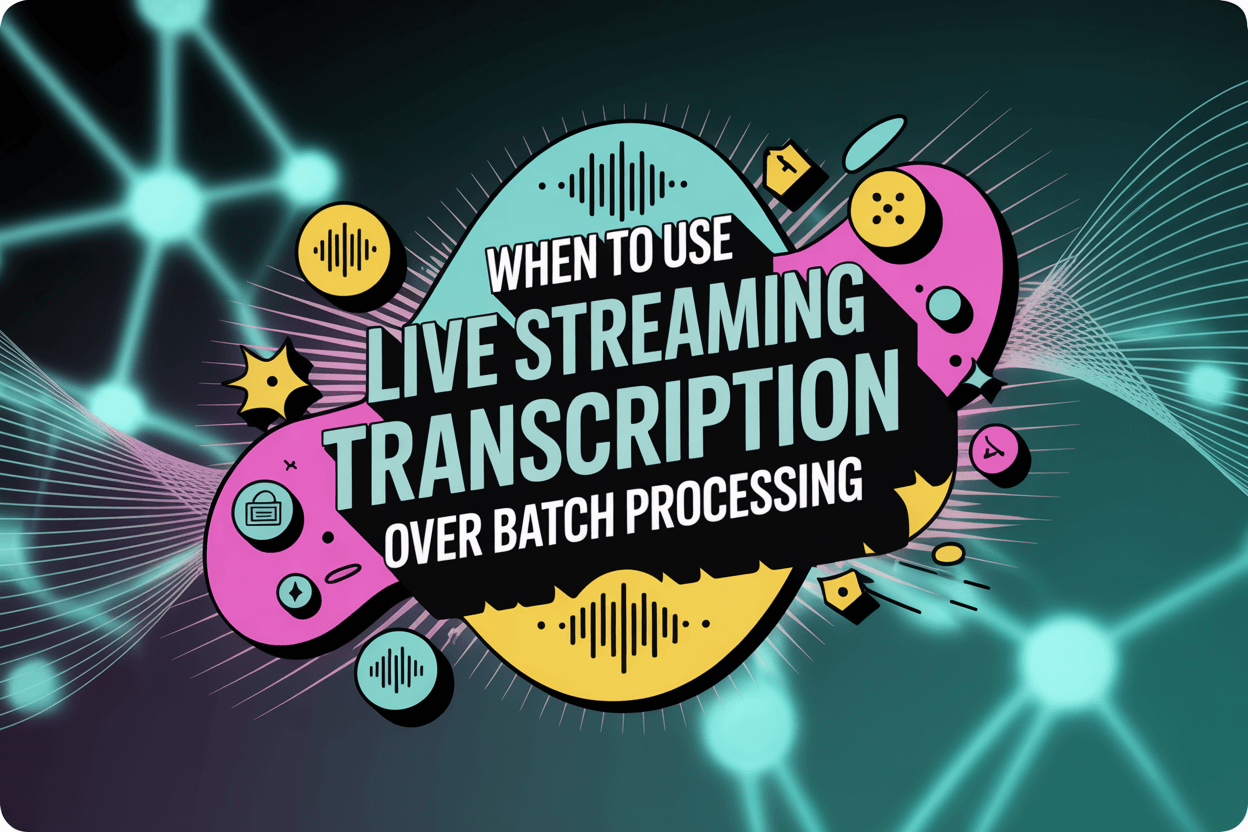Deve utilizar transcrição da transmissão em direto quando é necessário produzir texto em tempo real - por exemplo, durante reuniões em direto, webinars ou transmissões. Transcrição de processamento em lote, por outro lado, é melhor para ficheiros pré-gravados que podem ser processados após um evento. A escolha certa depende do facto de valorizar acesso imediato ou precisão pós-evento.

O que é a transcrição de transmissões em direto?
Transcrição da transmissão em direto converte as palavras faladas em texto no momento em que estão a ser ditas. Utiliza modelos de reconhecimento de voz em tempo real que captam, processam e apresentam o texto em segundos. Isto é especialmente útil quando os participantes ou espectadores necessitam de legendas ou notas imediatas.
Casos de utilização comuns
- Webinars em direto e eventos virtuais
- Educação e conferências em linha
- Chamadas de apoio ao cliente em direto
- Legendas de acessibilidade em tempo real
A transcrição em tempo real ajuda as equipas a manterem-se envolvidas e informadas instantaneamente. No entanto, uma vez que dá prioridade à velocidade, pode ser ligeiramente menos exacta do que os métodos em lote, especialmente em ambientes ruidosos ou com vários oradores.
O que é a transcrição de processamento em lote?
Transcrição de lotes - também conhecida como transcrição assíncrona ou offline - processa gravações de áudio ou vídeo após a sessão está concluída. Em vez de resultados imediatos, o sistema analisa todo o ficheiro antes de produzir uma transcrição, garantindo uma melhor pontuação, precisão e separação dos oradores.
Casos de utilização comuns
- Transcrição de podcasts e entrevistas
- Arquivos de reuniões empresariais
- Gravações de investigação académica
- Conversões de grandes bibliotecas multimédia
Este método funciona melhor para projectos em que a precisão, a formatação e o contexto são mais importantes do que a velocidade. É a solução ideal para organizações que gerem gravações longas ou documentação detalhada.
⚙️ Live vs Batch: Principais diferenças que você deve saber
| Caraterística | Transcrição da transmissão em direto | Processamento de lotes Transcrição |
|---|---|---|
| Velocidade | Saída instantânea e em tempo real | Atrasado mas completo |
| Exatidão | Moderado | Superior (sensível ao contexto) |
| Escalabilidade | Ideal para sessões em direto | Ideal para grandes bibliotecas |
| Casos de utilização | Reuniões, webinars | Investigação, pós-produção |
| Necessidade de Internet | Sempre necessário | Pode ser offline ou baseado na nuvem |
Em suma:
- Escolher transcrição em direto quando o momento é crítico.
- Escolher transcrição de lotes quando a precisão e a escalabilidade são mais importantes.
Utilização do VOMO.AI para transcrição em direto e em lote
Se precisar de uma ferramenta que suporte fluxos de trabalho em tempo real e em lote, VOMO.AI é uma escolha de topo. O seu motor de transcrição baseado em IA pode captar sessões em direto, permitindo também carregamentos em massa para análise pós-evento.
As equipas podem transcrever facilmente arquivos completos de reuniões, palestras ou entrevistas, mantendo a precisão e a formatação. Com o VOMO.AI, os utilizadores podem gerir áudio para texto e vídeo para texto conversões de forma eficiente - quer seja em tempo real ou em modo batch.
🎯 Quando é que se deve utilizar a transcrição de transmissões em direto?
Deve utilizar transcrição da transmissão em direto quando:
- O público precisa imediatamente de legendas ou de legendas.
- Pretende acessibilidade em tempo real para utilizadores com deficiência auditiva.
- Precisa de documentação em direto para eventos, palestras ou conferências.
- Está a planear integrar a saída de texto com transmissões de vídeo em direto ou chatbots.
Por exemplo, durante um webinar global, a transcrição em direto garante que todos os participantes podem acompanhar a discussão, independentemente do sotaque ou do ruído de fundo.
💼 Quando é que o processamento em lote é uma melhor escolha?
Utilização transcrição de lotes quando tem conteúdos gravados que não requerem legendas em direto, mas que precisam de uma transcrição limpa e exacta depois. Isto inclui podcasts, entrevistas gravadas ou grandes arquivos de vídeo.
O processamento em lote é ideal quando:
- Tem horas de multimédia para processar de uma só vez.
- São necessários dados estruturados, registos de data e hora ou resumos.
- O seu foco é a documentação, a conformidade ou a análise.
🧩 Escolher o fluxo de trabalho de transcrição correto
A abordagem ideal depende do seu fluxo de trabalho:
- Para velocidade: Ir com transcrição da transmissão em direto.
- Para maior precisão: Escolher processamento em lote.
- Para a versatilidade: Utilizar plataformas como VOMO.AI, que lhe permite alternar entre ambos, consoante o projeto.
Os sistemas modernos de IA permitem mesmo configurações híbridas - transcrições em direto durante os eventos, guardadas automaticamente e aperfeiçoadas mais tarde através do reprocessamento em lote para uma maior precisão.
Considerações finais
A decisão entre a transcrição de transmissão em direto e o processamento em lote depende do seu necessidades de tempo, expectativas de precisão e dimensão da carga de trabalho. Se estiver a organizar eventos ao vivo ou reuniões virtuais, a transcrição em tempo real mantém a comunicação sem problemas. Para arquivo e documentação, a transcrição em lote garante um resultado fiável e polido.
Com soluções avançadas como VOMO.AI, Se não tiver de escolher um em detrimento do outro, pode gerir ambos de forma eficiente num único local, garantindo uma transcrição rápida, precisa e escalável para todos os casos de utilização.



